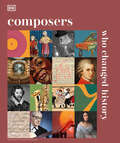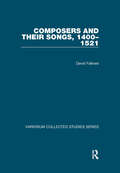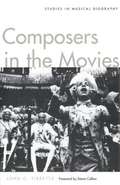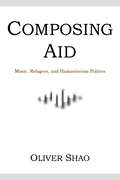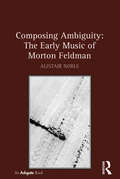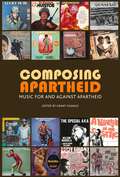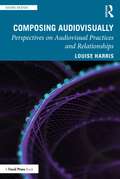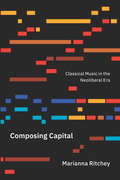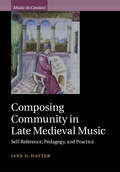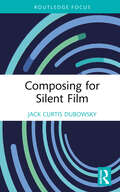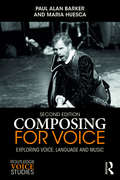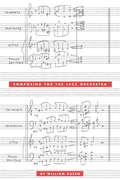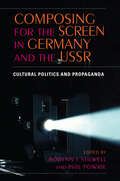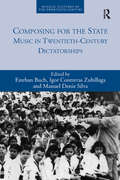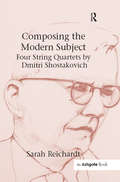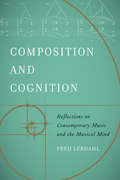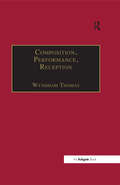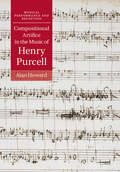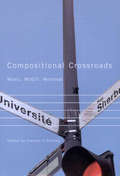- Table View
- List View
Composers Who Changed History (DK History Changers)
by DKThis intricate visual celebration of the world's most celebrated composers tells the fascinating stories of their lives and works.Whether you have an interest in classical music and opera or you are a music student or musician, this book would be great for you. Composers Who Changed History places well-known composers in their historical and cultural context, allowing you to see how they came to influence music. In this edition, you can find: -An overview of the lives and works of around 80 of the world's most important composers - from the Middle Ages to the present-Eight pages of brand-new content with 12 new entries, including Joseph Bologne and Margaret Bonds-Lavishly illustrated with portraits of each composer, alongside photographs of their homes and studios, and original musical scores and personal correspondenceEach composer is Introduced with a realistic portrait and biographical entries which trace the friendships, loves, and rivalries that inspired and influenced them. Composers Who Changed History provides revealing insights into what drove each individual to create the musical masterpieces - symphonies, concertos and operatic scores - that changed the direction of classical music. Making the perfect gift for any classical music enthusiast or musician.
Composers and their Songs, 1400–1521
by David FallowsThis second selection of essays by David Fallows draws the focus towards individual composers of the 'long' fifteenth century and what we can learn about their songs. In twenty-one essays on the secular works of composers from Ciconia and Oswald von Wolkenstein via Binchois, Ockeghem, Busnoys and Regis to Josquin, Henry VIII and Petrus Alamire, one repeated theme is how a consideration of the songs can help the way to a broader understanding of a composer's output. Since there are more song sources and more individual pieces now available for study, there are more handles for dating, for geographical location and for social alignment. Another theme concerns the various different ways in which particular songs have their impact on the next generations. Yet another concerns the authorshop of poems that were set to music by Binchois and Ciconia in particular. A group of essays on Josquin were parerga to the author's edition of his four-voice secular music for the New Josquin Edition (2005) and to his monograph on the composer (2009).
Composers in the Movies: Studies in Musical Biography
by John C. TibbettsAmadeus. . . Yankee Doodle Dandy. . . Swanee River. . . Rhapsody in Blue. Even before movies had sound, filmmakers dramatized the lives of composers. Movie biographies--or biopics--have depicted composers as diverse as Wolfgang Amadeus Mozart, George M. Cohan, Stephen Foster, and George Gershwin. In this enticing book, the first devoted entirely to such films, John C. Tibbetts surveys different styles and periods from the Hollywood of the 1920s and 1930s to the international cinema of today, exploring the role that film biographies play in our understanding of history and culture. Tibbetts delves into such questions as: How historically accurate are composer biopics? How and why have inaccuracies and distortions been perpetrated? What strategies have been used to represent visually the creative process? The book examines the films in several contexts and considers their role in commodifying and popularizing music. Extensive archival research, dozens of illustrations, and numerous interviews make this an appealing book for film and music enthusiasts at all levels.
Composers on Music: An Anthology of Composers' Writings from Palestrina to Copland
by Sam Morgenstern88 composers talk about music, ranging from the 1500s to the 1900s.
Composers: Their Lives and Works (DK History Changers)
by DK&“The only love affair I have ever had was with music.&” Maurice RavelA compelling celebration of more than 90 of the world&’s most influential composers from the medieval period to the present day, Composers reveals the fascinating stories of their lives, loves, and works. Biographical entries – introduced with a stunning portrait of each featured composer – trace the friendships, loves, and rivalries that inspired each musical genius. Profiles offer revealing insights into what drove each individual to create the musical masterpieces – symphonies, concertos, and operatic scores – that changed the direction of classical music and are still celebrated and treasured today.Lavishly illustrated with paintings or photographs of each composer, alongside original musical scores and personal correspondence, images of their homes and where they worked, and personal effects and other important artifacts, the book introduces the key influences, themes, and working methods of each individual, setting their works within a wider historical and cultural context. Charting the development of classical music and music movements across the centuries, Composers provides a compelling glimpse into the personal lives, loves, and influences of the giants of the classical music canon.
Composing Aid: Music, Refugees, and Humanitarian Politics (Activist Encounters in Folklore and Ethnomusicology)
by Oliver ShaoMusic and arts initiatives are often praised for their capacity to aid in the rehabilitation of refugees. However, it is crucial to recognize that this celebratory view can also mask the unequal power dynamics involved in regulating forced migration. In Composing Aid, Oliver Shao turns a critical ear towards the United Nations-run Kakuma Refugee Camp in Kenya, one of the largest and oldest encampments in the world. This politically engaged ethnography delves into various cultural practices, including hip hop shows, traditional dances, religious ceremonies, and NGO events, in an urbanized borderland area beset with precarity and inequality. How do songs intersect with the politics of belonging in a space controlled by state and humanitarian forces? Why do camp authorities support certain musical activities over others? What can performing artists teach us about the inequities of the international refugee regime?Offering a provocative contribution to ethnomusicological methods through its focus on activist research, Composing Aid elucidates the powerful role of music and the arts in reproducing, contesting, and reimagining the existing migratory order.
Composing Ambiguity: The Early Music Of Morton Feldman
by Alistair NobleAmerican composer Morton Feldman is increasingly seen to have been one of the key figures in late-twentieth-century music, with his work exerting a powerful influence into the twenty-first century. At the same time, much about his music remains enigmatic, largely due to long-standing myths about supposedly intuitive or aleatoric working practices. In Composing Ambiguity, Alistair Noble reveals key aspects of Feldman's musical language as it developed during a crucial period in the early 1950s. Drawing models from primary sources, including Feldman's musical sketches, he shows that Feldman worked deliberately within a two-dimensional frame, allowing a focus upon the fundamental materials of sounding pitch in time. Beyond this, Feldman's work is revealed to be essentially concerned with the 12-tone chromatic field, and with the delineation of complexes of simple proportions in 'crystalline' forms. Through close reading of several important works from the early 1950s, Noble shows that there is a remarkable consistency of compositional method, despite the varied experimental notations used by Feldman at this time. Not only are there direct relations to be found between staff-notated works and grid scores, but much of the language developed by Feldman in this period was still in use even in his late works of the 1980s.
Composing Apartheid: Music for and against apartheid
by Grant OlwageComposing Apartheid is the first book ever to chart the musical world of a notorious period in world history, apartheid South Africa. It explores how music was produced through, and was productive of, key features of apartheid’s social and political topography, as well as how music and musicians contested and even helped to conquer apartheid. The collection of essays is intentionally broad, and the contributors include historians, sociologists and anthropologists, as well as ethnomusicologists, music theorists and historical musicologists. The essays focus on a variety of music (jazz, music in the Western art tradition, popular music) and on major composers (such as Kevin Volans) and works (Handel’s Messiah). Musical institutions and previously little-researched performers (such as the African National Congress’s troupe-in-exile, Amandla) are explored. The writers move well beyond their subject matter, intervening in debates on race, historiography, and postcolonial epistemologies and pedagogies.
Composing Audiovisually: Perspectives on audiovisual practices and relationships (Sound Design)
by Louise HarrisWhat does the Coen Brothers’ Barton Fink have in common with Norman McLaren’s Synchromy? Or with audiovisual sculpture? Or contemporary music video? Composing Audiovisually interrogates how the relationship between the audiovisual media in these works, and our interaction with them, might allow us to develop mechanisms for talking about and understanding our experience of audiovisual media across a broad range of modes. Presenting close readings of audiovisual artefacts, conversations with artists, consideration of contemporary pedagogy and a detailed conceptual and theoretical framework that considers the nature of contemporary audiovisual experience, this book attempts to address gaps in our discourse on audiovisual modes, and offer possible starting points for future, genuinely transdisciplinary thinking in the field.
Composing Capital: Classical Music in the Neoliberal Era
by Marianna RitcheyThe familiar old world of classical music, with its wealthy donors and ornate concert halls, is changing. The patronage of a wealthy few is being replaced by that of corporations, leading to new unions of classical music and contemporary capitalism. In Composing Capital, Marianna Ritchey lays bare the appropriation of classical music by the current neoliberal regime, arguing that artists, critics, and institutions have aligned themselves—and, by extension, classical music itself—with free-market ideology. More specifically, she demonstrates how classical music has lent its cachet to marketing schemes, tech firm-sponsored performances, and global corporate partnerships. As Ritchey shows, the neoliberalization of classical music has put music at the service of contemporary capitalism, blurring the line between creativity and entrepreneurship, and challenging us to imagine how a noncommodified musical practice might be possible in today’s world.
Composing Community in Late Medieval Music: Self-Reference, Pedagogy, and Practice (Music in Context)
by Jane D. HatterWhen we sing lines in which a fifteenth-century musician uses ethereal polyphony to complain mundanely about money or hoarseness, more than half a millennium melts away. Equally intriguing are moments in which we experience solmization puns. These familiar worries and surprising jests break down temporal distances, humanizing the lives and endeavors of our musical forebears. Yet many instances of self-reference occur within otherwise serious pieces. Are these simply in-jokes, or are there more meaningful messages we risk neglecting if we dismiss them as comic relief? Music historian Jane D. Hatter takes seriously the pervasiveness of these features. Divided into two sections, this study considers pieces with self-referential features in the texts separately from discussions of pieces based on musical self-referential elements. Examining connections between self-referential repertoire from the years 1450–1530 and similar self-referential creations for painters' guilds, reveals musicians' agency in forming the first communities of early modern composers.
Composing Digital Music For Dummies
by Russell Dean VinesYes, you can turn those great melodies and smokin' grooves in your head into stunning digital music! And you don't have to be a musical genius or a computer geek to do it! Composing Digital Music For Dummies shows you everything you need to know to compose great tunes using the hottest digital tools. This friendly, plain-English guide explains all of the digital music basics, including how to work with the latest hardware and software, use templates from the companion CD-ROM to make a quick start, build your first tune, and save it in different formats. You'll also find out how to add instruments to your score, set tempos and keys, create chord symbols and show fretboards, add lyrics to your tune, and much more. Discover how to: Write and arrange digital music Determine what - if any - equipment you need Create your own ringtones and mp3s Compose with a MIDI controller, or a mouse Work with notation software Use keyboard shortcuts Publish your creations on the Internet Build your own tune from scratch Extract parts from your score for each instrument The companion CD-Rom also includes a demo of Sebelius 5, the most popular music notation software, as well as audio files for all music examples in the book. With this step-by-step guide and your computer, you'll have everything you need to start writing, arranging, and publishing your own digital music - immediately! Note: CD-ROM/DVD and other supplementary materials are not included as part of eBook file.
Composing for Silent Film
by Jack Curtis DubowskyComposing for Silent Film offers insight, information, and techniques for contemporary composition, arrangement, and live score performance for period silent film. A specialized music composition guide, this book complements existing film scoring and contemporary music composition texts. This book helps today’s composers better understand and correctly interpret period silent film, and to create and perform live scores that align with films’ original intentions, so that audiences notice and grasp fine points of the original film. Composing for Silent Film analyzes period silent film and its conventions – from Delsarte acting gestures to period fascinations and subtexts. As a practical composition text, it weighs varying approaches, including improvisation, through-scoring, "mickey-mousing," handling dialogue, and dividing roles amongst players. It steers composers towards informed understanding of silent film, and encourages them to deploy contemporary styles and techniques in exciting ways.For clarity and concision, examples are limited to nine canonical silents: Metropolis, Dr. Jekyll and Mr. Hyde, The Mark of Zorro, Sunrise: A Song of Two Humans, The Black Pirate, Nosferatu, The Phantom Carriage, Daisy Doodad’s Dial, and The Golem.
Composing for Voice: Exploring Voice, Language and Music (Routledge Voice Studies)
by Paul Barker Maria HuescaComposing for Voice: Exploring Voice, Language and Music, Second Edition, elucidates how language and music function together from the perspectives of composers, singers and actors, providing an understanding of the complex functions of the voice pedagogically, musicologically and dramatically. Composing for Voice examines the voice across a wide range of musical genres (including pop, jazz, folk, classical, opera and the musical) and explores the fusion of language and music that is unique to song. This second edition is enlarged to attract a wider readership amongst all music and theatre professionals and educators, whilst also engaging an international audience with the introduction of new co-author Maria Huesca. New to the second edition: A review of the history of singing An overview of the development of melisma A chapter to help performers understand each other, as singers and actors often receive disparate educations Case studies and qualitative research around song, lyric and meaning A discussion of the synthetic voice An introduction to the concept of embodied composition Interviews with composers and singers Summaries of various vocal styles A website with links to performances discussed, as well as related workshops: www.composingforvoice.com Composing for Voice: Exploring Voice, Language and Music, Second Edition, articulates possibilities for the practical exploration of language, music and voice by composers, singers and actors.
Composing for the Jazz Orchestra
by William Russo"Although it will be of primary interest to those who are engaged in composition themselves, [this] book is also recommended for readers who may wish to gain further insight into just what makes jazz composition so different from traditional approaches."—Malcolm Bessom, The Music Magazine
Composing for the Screen in Germany and the USSR: Cultural Politics and Propaganda
by Phil Powrie Robynn J. StilwellDespite the long history of music in film, its serious academic study is still a relatively recent development and therefore comprises a limited body of work. The contributors to this book, drawn from both film studies and musicology, attempt to rectify this oversight by investigating film music from the vibrant, productive, politically charged period before World War II. They apply a variety of methodologies--including archival work, close readings, political histories, and style comparison--to this under explored field.
Composing for the State: Music in Twentieth-Century Dictatorships (Musical Cultures of the Twentieth Century)
by Esteban Buch Igor Contreras Zubillaga Manuel Deniz SilvaUnder the dictatorships of the twentieth century, music never ceased to sound. Even when they did not impose aesthetic standards, these regimes tended to favour certain kinds of art music such as occasional works for commemorations or celebrations, symphonic poems, cantatas and choral settings. In the same way, composers who were more or less ideologically close to the regime wrote pieces of music on their own initiative, which amounted to a support of the political order. This book presents ten studies focusing on music inspired and promoted by regimes such as Nazi Germany, Fascist Italy, France under Vichy, the USSR and its satellites, Franco's Spain, Salazar's Portugal, Maoist China, and Latin-American dictatorships. By discussing the musical works themselves, whether they were conceived as ways to provide "music for the people", to personally honour the dictator, or to participate in State commemorations of glorious historical events, the book examines the relationship between the composers and the State. This important volume, therefore, addresses theoretical issues long neglected by both musicologists and historians: What is the relationship between art music and propaganda? How did composers participate in musical life under the control of an authoritarian State? What was specifically political in the works produced in these contexts? How did audiences react to them? Can we speak confidently about "State music"? In this way, Composing for the State: Music in Twentieth Century Dictatorships is an essential contribution to our understanding of musical cultures of the twentieth century, as well as the symbolic policies of dictatorial regimes.
Composing the Citizen: Music as Public Utility in Third Republic France
by Jann PaslerComposing the Citizen demonstrates how music can help forge a nation. Deftly exploring the history of Third Republic France, Jann shows how French people from all classes and political persuasions looked to music to revitalize the country after the turbulent crises of 1871.
Composing the Modern Subject: Four String Quartets by Dmitri Shostakovich
by Sarah ReichardtSince the publication of Solomon Volkov's disputed memoirs of Dmitri Shostakovich, the composer and his music has been subject to heated debate concerning how the musical meaning of his works can be understood in relationship to the composer's life within the Soviet State. While much ink has been spilled, very little work has attempted to define how Shostakovich's music has remained so arresting not only to those within the Soviet culture, but also to Western audiences - even though such audiences are often largely ignorant of the compositional context or even the biography of the composer. This book offers a useful corrective: setting aside biographically grounded and traditional analytical modes of explication, Reichardt uncovers and explores the musical ambiguities of four of the composer‘s middle string quartets, especially those ambiguities located in moments of rupture within the musical structure. The music is constantly collapsing, reversing, inverting and denying its own structural imperatives. Reichardt argues that such confrontation of the musical language with itself, though perhaps interpretable as Shostakovich's own unique version of double-speak, also poignantly articulates the fractured state of a more general form of modern subjectivity. Reichardt employs the framework of Lacanian psychoanalysis to offer a cogent explanation of this connection between disruptive musical process and modern subjectivity. The ruptures of Shostakovich's music become symptoms of the pathologies at the core of modern subjectivity. These symptoms, in turn, relate to the Lacanian concept of the real, which is the empty kernel around which the modern subject constructs reality. This framework proves invaluable in developing a powerful, original hermeneutic understanding of the music. Read through the lens of the real, the riddles written into the quartets reveal the arbitrary and contingent state of the musical subject's constructed reality, reflecting pathologies ende
Composition and Cognition: Reflections on Contemporary Music and the Musical Mind
by Fred LerdahlIn Composition and Cognition, renowned composer and theorist Fred Lerdahl builds on his careerlong work of developing a comprehensive model of music cognition. Bringing together his dual expertise in composition and music theory, he reveals the way in which his research has served as a foundation for his compositional style and how his intuitions as a composer have guided his cognitively oriented theories. At times personal and reflective, this book offers an overall picture of the musical mind that has implications for central issues in contemporary composition, including the recurrent gap between method and result, and the tension between cognitive constraints and utopian aesthetic views of musical progress. Lerdahl’s succinct volume provides invaluable insights for students and instructors, composers and music scholars, and anyone engaged with contemporary music.
Composition, Chromaticism and the Developmental Process: A New Theory of Tonality
by Henry BurnettMusicology, having been transmitted as a compilation of disparate events and disciplines, has long necessitated a 'magic bullet', a 'unified field theory' so to speak, that can interpret the steady metamorphosis of Western art music from late medieval modality to twentieth-century atonality within a single theoretical construct. Without that magic bullet, discussions of this kind are increasingly complicated and, to make matters worse, the validity of any transformational models and ideas of the natural evolution of styles is questioned and even frowned upon today as epitomizing a grotesque teleological bigotry. Going against current thinking, Henry Burnett and Roy Nitzberg claim that the teleological approach to observing stylistic change is still valid when considered from the purely compositional perspective. The authors challenge the traditional understanding of development, and advance a new theory of eleven-pitch tonality as it relates to the corpus of Western composition. The book plots the evolution of tonality and its bearing on style and the compositional process itself. The theory is not based on the diatonic aspect of the various tonal systems exploited by composers; rather, the theory is chromatically based - the chromatically inflected octave being the source not only of a highly ingenious developmental dialectic, but also encompassing the moment-to-moment progression of the musical narrative itself. Even the most profound teachings of Schenker, and the often startlingly original and worthwhile speculations of Riemann, Tovey, Dahlhaus and others, still provide no theory of development and so are ultimately unable to unite the various tendrils of the compositional organism into a unified whole. Burnett and Nitzberg move beyond existing theory and analysis to base their theory from the standpoint of chromatic 'pitch fields'. These fields are the specific chromatic pitch choices that a composer uses to inform and design a complete composition, utilizing
Composition, Performance, Reception: Studies in the Creative Process in Music
by Wyndham ThomasComposers, performers, listeners, critics and theorists all play vital roles in the creation of music culture; yet often each group can appear to hold widely divergent views of a musical work‘s aims and effects. As the title indicates, this book examines the parts played by these groups and the interaction between them. In the first of eleven essays, Robert Saxton discusses the difficulty in pin-pointing the moment of inspiration for a new composition; while Raymond Warren looks at the problems facing operatic performers, including those that arise when interpretations are suggested by the libretto but not in the music. The changing perception of the composer's art from the 14th century to the present day is charted by Wyndham Thomas, in particular attitudes towards arrangement. Two quite different views of the performer‘s responsibility in communicating the composer‘s intentions are taken by Charles Rosen and Susan Bradshaw, the latter arguing for the need to bridge the gap between theoretical and practical analysis of a work; and in two fascinating case studies, Eric Clarke and Jennifer Davidson highlight the ways in which attention to movements of the body in performance can reveal aspects of musical structure. The reception of music is tackled from a variety of perspectives in the book. In his assessment of audience reaction to Jonathan Harvey‘sThe Riot Adrian Beaumont concludes that our response is influenced by a complex web of expectations and previous musical experience. The influence of record sleeves in also determining a listener‘s response to music is discussed by Nicholas Cook; while Stephen Walsh and Adrian Thomas explore two milieux of critical reception - the first to the music of Stravinsky, and the second to works composed during the social-realist period in Poland. On a more personal level, Bojan Bujic‘s essay forms a fitting counterpart to Saxton‘s in his attempt to locate the ways in which we experience a new musica
Composition, Printing and Performance: Studies in Renaissance Music (Variorum Collected Studies)
by Bonnie J. BlackburnThe first articles here focus on Johannes Tinctoris, the prominent late 15th-century music theorist. They deal with the discovery of his lost pedagogical motet, and his treatise on counterpoint; this forms the basis of a wide-ranging investigation of contemporary practices of improvisation and composition (singing super librum and writing res facta), in which the question of ’successive’ and ’simultaneous’ composition is reconsidered. Tinctoris's sometimes sharp rebukes to famous composers are also investigated in the context of works by Ockeghem. Ottaviano Petrucci's first publication of music, the ’Odhecaton’ of 1501, is the subject of another three articles. These identify the editor of the work, and make new proposals on the provenance and editing of this repertory. The last article presents an edition of a treatise of ca. 1600 in the form of a letter from the virtuoso cornettist Luigi Zenobi to an unknown prince, which offers new insights on the change in performance practice at the end of the Renaissance.
Compositional Artifice in the Music of Henry Purcell (Musical Performance and Reception)
by Alan HowardFugal invention has proved a successful line of analytical inquiry in recent studies of repertoires from Josquin to J. S. Bach. Alan Howard brings similar insights to the music of Henry Purcell, and proposes the first analytical approach to his music to examine compositional methods alongside historically contemporary theory, focusing particularly on Purcell's 'artificial' approach to imitative counterpoint. Through this methodology Howard challenges previous responses to Purcell's music that portrayed him as fundamentally conservative. This study offers fresh insights into the musical world in which Purcell lived and worked and situates Purcell's compositional concerns in the broader context of notions of artifice in Restoration culture. Howard thereby offers both a fresh analytical approach - to Purcell's early instrumental works and to his later concerted vocal music - and a critique of the reception history surrounding the fantazias and sonatas in particular.
Compositional Crossroads
by Eleanor V. StubleyVisionary deans, composers, musicologists, and students associated with the Faculty of Music between 1970-2004 offer insights into the early contributions of Istvan Anhalt, the birth of the Electronic Music Studio and McGill Records, the importance of visiting composer-teachers, opportunities for composer/performer collaborations, the development of performing spaces and ensembles, and new ways of considering sonic creativity. Several essays are devoted to major composers who taught at the school, including Bengt Hambraeus, alcides lanza, Brian Cherney, Bruce Mather, John Rea, and Denys Bouliane.
